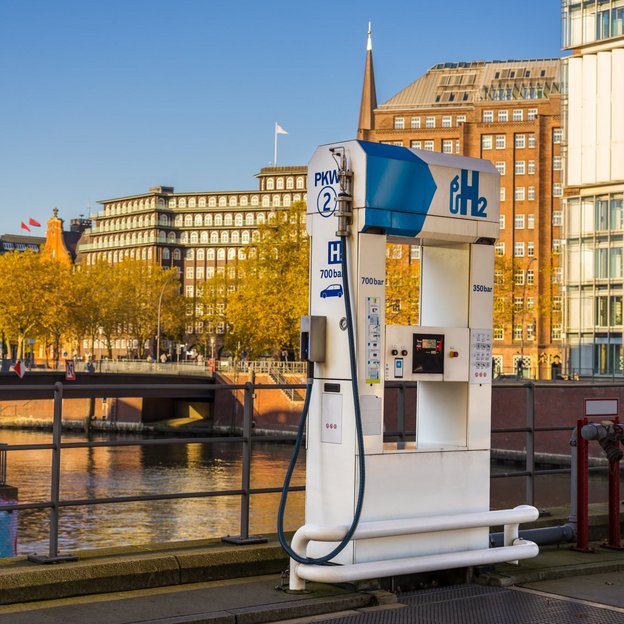What is hydrogen? Explained simply!


Hydrogen is currently being touted as the miracle cure for the energy revolution. The smallest element in the universe is set to make transport and industry more environmentally friendly. We have dealt with this promising gas in numerous articles. We provide an overview and answers to the most important questions.
All about the smallest element in the universe, its use and its environmental compatibility.
Hydrogen is the smallest and most common element in the universe. Unlike on the sun, Saturn or Jupiter, the colourless and odourless gas occurs on Earth almost exclusively in bound form: It is found in fossil raw materials such as natural gas and crude oil as well as in over half of all known minerals. And as its name and chemical symbol "H2" suggests, hydrogen on Earth is mainly bound in H2O, i.e. in water.
Today, hydrogen is mainly produced from natural gas by means of steam reforming. This releases a lot of CO2, which makes it not as environmentally friendly as commonly thought. Alternatively, hydrogen can also be produced using electricity in an electrolysis process. In this process, water is split into hydrogen and oxygen. If only electricity from renewable sources is used, the hydrogen is considered CO2-free. It could also be produced directly at the source - at wind farms on the high seas. We have summarised the advantages this would bring and where such floating electrolysis platforms are already being planned or considered.
How good hydrogen is for climate protection depends heavily on its production method. It has become common practice to categorise it in colours depending on its environmental compatibility: grey, green, blue, turquoise. Verena Schneider from TÜV NORD explains in an interview, which method is behind which colour and how to turn grey hydrogen into blue hydrogen, for example.
The EU's climate protection targets, the German government's savings targets and increasing sustainability requirements are forcing a rapid transformation of energy systems.
Carsten Gelhard, Head of HydroHub, which supports energy companies, industries and local authorities in the field of hydrogen.
TÜV NORD GROUP
The volatile gas is already used in large quantities in refineries and in the chemical industry - although it is mainly hydrogen, which is harmful to the climate and causes high emissions. This is set to change in the future. Green hydrogen from green electricity can play a fundamental role in the energy transition in transport and industry. What fields of application already exist?
The hydrogen drive is not a contemporary idea. In fact, the first hydrogen vehicle was built over 200 years ago. For a long time, people wanted to power combustion engines with the explosive gas, but in the meantime the fuel cell drive has established itself technologically. It works like an inverted electrolyser: hydrogen is split into water and electricity using oxygen from the ambient air. The former seeps out of the exhaust pipe, the latter drives an electric motor. Fuel cell cars are therefore also electric vehicles. Compared to purely battery-powered vehicles, however, they promise a greater range and can be refuelled almost as quickly as a combustion engine - according to the arguments of hydrogen advocates.
Leif-Erik Schulte, Head of the TÜV NORD Institute for Vehicle Technology and Mobility (IFM), explains why fuel cells have struggled so far in passenger cars, how this could change and where Germany stands in terms of refuelling infrastructure in the podcast. You can also read why the fuel cell is a promising alternative to diesel, especially in heavy goods transport. promising alternative to diesel in heavy goods transport.
Deutsche Bahn vehicles consume 250 million litres of diesel a year - the aim is to achieve zero litres by 2050. In order to realise this plan, the Group also wants to use hydrogen trains in the future. Especially on non-electrified branch lines, where overhead lines are hardly worthwhile. Regional train operators such as EVB in Lower Saxony have already successfully trialled hydrogen trains in recent years: From 2022, 14 fuel cell trains are to be in regular service in the Elbe-Weser region. Find out in the following article, which transport operators are also planning to use hydrogen and which manufacturers are developing models.
Around 90 per cent of global goods traffic travels across the world's oceans. And waterborne transport will continue to grow in the coming years - and with it the impact on the environment. Many experts agree that there is no silver bullet for clean shipping. We have summarised which measures and alternative drive systems are being discussed, trialled or already in use and where hydrogen comes into play.
Today, air travel is considered the number one climate polluter. One thing is clear: no other mode of transport has a greater impact on the climate per kilometre travelled. Experts are equally undisputed: Even in the distant future, we will not be able to fly people and goods to their destinations over long distances fully electrically. Today's batteries are too big and too heavy for that. In addition to biofuels, politicians and the aviation industry are therefore pinning their hopes on hydrogen. This could be used directly as a fuel or processed into synthetic paraffin, which can generally be refuelled in today's aircraft. What is advantageous over which distances and how the hydrogen aeroplane of the future Jens Friedrich, Head of the Institute of Aircraft Propulsion and Turbomachinery (IFAS) at the TU Braunschweig, knows what the hydrogen aircraft of the future could look like.
With a share of 24 per cent, industry was the second largest CO2 producer in Germany in 2020 - ahead of transport, which contributed 20 per cent. In future, hydrogen is to make the production of steel, fuels and basic chemicals more climate-friendly. Find out which projects are planned, what challenges need to be overcome and where the electricity for the green hydrogen could come from.